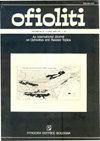The boeotian flysch revisited: New constraints on ophiolite obduction in central Greece
IF 1.3
4区 地球科学
Q2 GEOLOGY
引用次数: 7
Abstract
This paper reports new data on biostratigraphy, stratigraphy and syn-sedimentary deformation of the so-called “Boeotian Flysch” cropping out in key areas in Central Greece (Levadhia, Parnassus, Iti). Because of its age, sedimentary evolution and mechanisms of the syn-sedimentary deformation, the Boeotian Flysch represents a key element providing useful hints on the Cretaceous paleogeography reconstruction of the Dinaric-Hellenic Chain and in particular on the obduction at the Jurassic-Cretaceous transition in the eastern continental margin of the Adria plate. We provide here a new detailed study of different features of the Boeotian Flysch, with particular emphasis on reconstructing and dating its stratigraphy. In particular, we recognized two distinct turbiditic systems: the Lower Boeotian Flysch (Tithonian?-Aptian) and the Upper Boeotian Flysch (Cenomanian-Coniacian), which are separated by a main unconformity marking a sedimentary hiatus lasting from Aptian p.p. to Albian. By means of the improvement of the age, stratigraphy and deformation history of this syn-tectonic turbidite deposit, we therefore contribute to better define the chronology of the early phases of continental stage of obduction, and the following continental collision between Adria and Eurasia. The analyses of the collected data allowed us to propose for the Boeotian Flysch a deposition within an obduction-related foredeep basin associated with a flexural depression/flexural bulge due to crustal loading of westerly-directed ophiolite obduction.古埃及复理石的重新考察:希腊中部蛇绿岩逆冲的新限制
本文报道了在希腊中部(Levadhia, Parnassus, Iti)重点地区出现的所谓“Boeotian Flysch”生物地层学、地层学和同沉积变形的新资料。由于其时代、沉积演化和同沉积变形机制,布奥tian弗理石是为重建迪那拉-希腊链的白垩纪古地理,特别是亚德里亚板块东部大陆边缘侏罗纪-白垩纪过渡时期的逆冲提供有用线索的关键元素。本文对渤奥田弗理石的不同特征进行了新的详细研究,重点是重建其地层和定年。特别地,我们发现了两个不同的浊积体系:下布奥梯统弗理石统(梯通统-阿普梯统)和上布奥梯统弗理石统(塞诺曼尼亚统-柯尼亚斯统),它们被一个主要不整合面隔开,标志着从阿普梯统到阿尔比统的沉积间断。通过对该同构造浊积岩的年代、地层和变形史的研究,有助于更好地确定大陆早期逆冲阶段的年代学,以及随后亚德里亚-欧亚大陆碰撞的年代学。通过对收集到的数据的分析,我们提出了Boeotian Flysch沉积在一个与逆冲相关的前深盆地内,该盆地与由向西蛇绿岩逆冲的地壳负荷引起的弯曲凹陷/弯曲隆起有关。
本文章由计算机程序翻译,如有差异,请以英文原文为准。
求助全文
约1分钟内获得全文
求助全文
来源期刊

Ofioliti
地学-地质学
CiteScore
2.40
自引率
7.70%
发文量
1
期刊介绍:
Since 1976, Ofioliti provides an international forum for original contributions and reviews in the field of the geodynamics, petrology, geochemistry, biostratigraphy, stratigraphy, tectonics and paleogeography applied to ophiolitic terrains and modern oceanic lithosphere, including their sedimentary cover. Studies of topics such as geodynamics of the mantle, the evolution of orogens including ophiolites and paleoceanography are also welcome
 求助内容:
求助内容: 应助结果提醒方式:
应助结果提醒方式:


